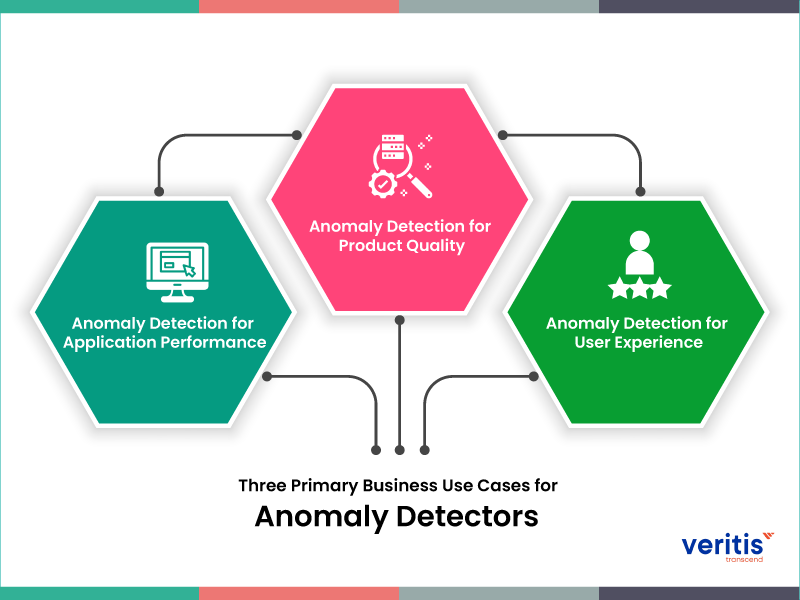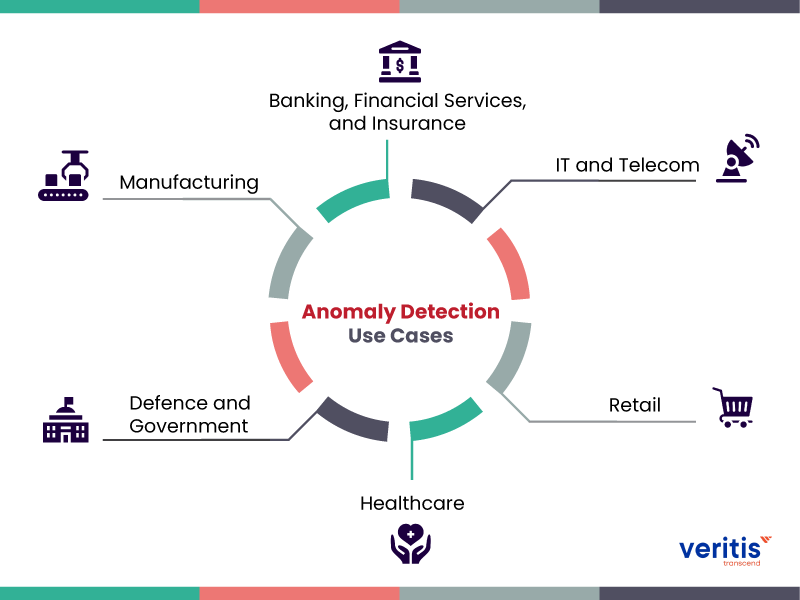
It is pragmatic to say that the Industrial Internet of Things will one day alter the course of history. The proliferation of data is currently what accelerates the pace of the globe. Big data went from being the Holy Grail to a challenge as it was piled up with often intractable datasets, forcing companies and organizations to make quicker decisions in real-time.
Detecting anomalous occurrences, modifications, or shifts in datasets can help you analyze data more quickly and effectively. As a result, one of the critical goals of the Industrial IoT has become anomaly detection. This is a technique that uses artificial intelligence to find unexpected behavior within the data collection.
Robust distributed anomaly detection software systems rely heavily on anomaly detection. To discover anomalies:
- Improve system behavior communication
- enhance your root cause analysis
- Decreasing the risk to the anomaly detection software ecosystem
Healthcare, financial services, government, sports, and entertainment are just a few fields and companies using AI and ML for anomaly detection technologies. AI and ML technologies have successfully automated digital and manual tasks. Additionally, they were crucial in extracting information from the vast volumes of text and numerical data. It is created by several systems that employ text mining and natural language processing techniques.
“AI in anomaly detection is one particular field that is gaining traction. Several industries have used anomaly detection to improve operations successfully. As a result, the market for anomaly detection is anticipated to grow to USD 4.45 billion by 2023.”
As we step into 2024, the field of anomaly detection in ML and AI continues to experience remarkable growth and innovation. Projections indicate that the global anomaly detection market is poised to reach a staggering USD 26.51 billion by 2027, driven by a solid CAGR of 18.5% from 2022 onwards (Source: Grand View Research). This expansion is primarily fueled by increased adoption across critical sectors like healthcare, finance, manufacturing, and IT security.
Notably, the field is witnessing notable technological advancements, with anomaly detection deep learning algorithms like Autoencoders and One-Class SVMs showcasing promising capabilities in identifying intricate anomalies. Additionally, the rise of Explainable AI (XAI) is gaining momentum, providing users with crucial insights into the decision-making processes of AI anomaly detection models.
Furthermore, the integration of edge computing facilitates real-time network anomaly detection at the data source, a vital feature for time-sensitive applications. These trends and statistics highlight the exciting developments in anomaly detection.
The anomaly detection system is a technique used for finding unusual occurrences or observations which are statistically distinct from the rest of the observations. Such “anomalous” behavior usually indicates issues like credit card fraud, a failed server machine, a cyberattack, etc. Three general categories can be used to classify anomalies:
- Collective Anomaly: An anomaly can be found using a collection of data anomaly detection
- Point Anomaly: A tuple that differs noticeably from the remaining data in a dataset is referred to as a point anomaly.
- Contextual Anomaly: An observation qualifies as a contextual anomaly if its context causes it to be anomalous.
Anomaly detection identifies things or events that do not follow an anticipated pattern. Or else to other elements in a dataset that a human expert would typically be unable to discover. Such anomalies typically translate into issues like structural flaws, mistakes, or fraud.
What is Anomaly Detection?

Anomaly detection is locating unusual occurrences, objects, or suspicious observations because they diverge dramatically from expected patterns. Anomaly detection algorithms process any method that identifies the dataset’s outliers, those items that don’t belong. These anomalies may indicate spontaneous network activity, a malfunctioning sensor, or the need for data cleaning before analysis. Data anomalies can also be called outliers, noise, novelty, and exceptions.
Anomaly detection is frequently used in enterprise IT for:
- Fraud Detection
- Data Cleaning
- Intrusion Detection
- Ecosystem Disturbances
- Systems Health Monitoring
- Event Detection in Sensor Networks
Unusual data can point to severe occurrences, such as technological malfunction, or promising opportunities, a shift in consumer behavior. As a result, automating anomaly detection machine learning is becoming increasingly common.
Useful link: Understanding the Differences Between Deep Learning and Machine Learning
Different Types of Anomaly Detection
AI/ML can identify outliers using various strategies, including supervised, semi-supervised, and unsupervised anomaly detection techniques.
1) Supervised Detection
The most labor-intensive type of detection is supervised detection, which requires a person to identify two categories—normal and abnormal—within a data set. As a result of the human assignment, the machine can detect trends. One must ensure that the training data sets are of high caliber to avoid learning errors. If this happens, this technique becomes quite effective in identifying outliers.
2) Unsupervised Detection
When labeling data sets for unsupervised detection, no manual labor is necessary. Undoubtedly, this saves much time, but there is a drawback. It takes much effort to build such a system. The likelihood of AI learning mistakes increases because the learning is unsupervised. Unsupervised detection is less dependable than supervised detection because of these factors.
3) Semi-Supervised Detection
The two strategies mentioned above are combined in semi-supervised detection. It’s essential to strike the correct balance between efficiency and precision. Controlling how AI anomaly detection learns while using unsupervised learning techniques to automate feature learning with unstructured data frequently enables combining the finest aspects of both worlds.
Why is Anomaly Detection Important?
In order to acquire a complete picture of their business, modern firms are starting to recognize the value of networked operations. Additionally, they must react quickly to rapid data changes, particularly in the event of cybersecurity concerns. Finding anomalies can be essential for resolving such intrusions. As with detecting anomalies, deviations from the norm point to intentional or unintentional attacks, flaws, or other issues.
Unfortunately, there is no practical way to manage and evaluate rapidly expanding datasets by hand. A new proactive strategy to discover anomalous behavior is required, given that dynamic systems include various components that are always changing and where “normal” behavior is constantly redefined.
How does Anomaly Detection Work?
Machine learning is a critical component of anomaly detection methods. Anomaly detection machine learning can be used to learn a system’s features from observed data to enhance the detection speed. Machine learning anomaly detection algorithms can make predictions based on the data and learn from it. Additionally, they enhance their capacity for prediction by “learning” from the outcomes of their original forecasts as the actual events transpire (the feedback loop).
Anomaly detection techniques for machine learning allow you to quickly find and categorize anomalies in vast and intricate big data sets. It is used for spotting changes in the distributions of real-time data and establishing alarm settings.
Useful link: Top 15 AWS Machine Learning Tools in the Cloud
Why Does Your Organization Requires Anomaly Detection?

You may now more efficiently measure every area of business activity with the help of the numerous anomaly detection tools and anomaly detection software options available. This includes key performance indicators (KPIs) that measure your company’s success and the operational performance of applications and infrastructure components.
Millions of metrics result in a vast and constantly growing dataset that can explore. But what takes place when data patterns unexpectedly change? These anomalies—differences from the norm—are brought on by business-related situations. Whether it’s a new, effective marketing strategy that generated more leads, a promotion-driven discount that increased sales, or a pricing error reducing profit. Or something in between, you must be able to identify the underlying cause.
Anomaly detection algorithms offer countless different ways to learn new things. However, the three primary business use cases for anomaly detectors are application performance, product quality, and user experience.
1) Anomaly Detection for Application Performance
Application performance has a direct impact on revenue and employee productivity. You can only respond to problems using traditional, reactive application performance monitoring methods and letting problems affect your company before you become aware.
Waze decided that an anomaly detector was necessary to find and fix any application performance issues before they impacted consumers. Waze has over 100 million monthly active users worldwide.
Anomaly detection deep learning uses techniques to seamlessly correlate data with pertinent application performance metrics to provide a complete account of business problems so that the IT team may respond appropriately.
However, other businesses outside software and app developers like Waze might gain from network anomaly detection system for better application performance. The following sectors can profit as well:
A) Adtech
There is a limited place for manual KPI monitoring while processing trillions of monthly transactions with real-time auctions that happen in 40 milliseconds. Technical data centre issues may be tracked by operations teams, but sophisticated application performance trends are harder to predict. Anomaly detected is used by Rubicon Project, one of the biggest ad exchanges in the world, to track all transactions in real-time and keep its market for advertising healthy.
B) Telco
There is a limited place for manual KPI monitoring while processing trillions of monthly transactions with real-time auctions that happen in 40 milliseconds. Operations teams may track technical data center issues, but sophisticated application performance trends take more work to predict. Anomaly detected is used by Rubicon Project, one of the biggest ad exchanges in the world, to track all transactions in real-time and keep its market for advertising healthy.
2) Anomaly Detection for Product Quality
For product managers, more is needed to assume that all other departments will handle the essential monitoring and notifications. You must have faith that the product will function properly from the time of initial rollout to each time a new feature is added.
Every version release, A/B test, new feature, modification to the purchase funnel, or alteration to customer assistance might trigger abnormal behavior because your product constantly evolves. Missing these product irregularities will cost your business millions of dollars in lost income and tarnished brand reputation if you don’t correctly monitor for them.
The following are two prime examples of how anomaly based detection may be advantageous for any product-based business:
A) Fintech
Any digital firm must prioritize security, but fintech companies must prioritize it even more. Your responsibility is to remain ahead of refined attacks since clients and business partners need comfort that transactions are handled securely.
B) Ecommerce
Developers can handle the technical parts of monitoring an eCommerce platform, but someone needs to keep an eye on the conversion rates and business funnel. The product manager is responsible for this. However, you’ll miss out on crucial alarms in the context of seasonality if you depend on fixed points to monitor dynamic funnel ratios.
3) Anomaly Detection for User Experience
When you deploy a flawed version. Encounter a DDoS assault. Or experience a customer service process change that fails. You run the danger of having use lapses across client interactions.
As a result of proactive streamlining and improving user experiences, customer satisfaction will increase in a variety of businesses, including:
A) Online Business
Any online business must operate smoothly. IT must immediately address API problems, load-time issues, server downtime, and other issues if the UX remains unaffected. Across all platforms, operating systems, and data centres, anomaly detection provides full coverage and quick response times. Anomaly based detection for Wix entails quick root cause investigation of all possible problems through a solitary and unified platform.
B) Gaming
Manual points cannot be used to track the permutational complexity of gaming sessions. AI-based anomaly detection solutions keep track of operating systems, levels, user segments, and various devices to make sure that bugs and faults that may impair can rapidly fix user experience. Outfit7 uses network anomaly detection because it enables them to predict and handle problems as their games develop.
Useful link: How AI Adoption Will Transform Your Business
Why is Machine Learning Crucial for Anomaly Detection?
For several compelling technical reasons, machine learning plays a pivotal role in anomaly detection. Anomaly detection is an intricate process aimed at identifying deviations from expected patterns. Integrating anomaly detection with machine learning becomes imperative as organizations expand and deal with increasingly intricate operations. Here are the technical underpinnings of this necessity:
1) Handling Big Data
Organizations handle massive and diverse datasets in the modern business field, encompassing transactions, textual data, images, videos, and more. Manual inspection of such vast datasets could be more practical due to time constraints and resource limitations. Machine learning’s ability to efficiently process large volumes of data anomaly detection is essential for deriving valuable insights.
2) Dealing With Unstructured Data
A substantial portion of business data is unstructured, lacking predefined formats suitable for traditional analysis. This includes documents, emails, and images, presenting a challenge for conventional methods. Anomaly detection with machine learning excels in processing unstructured data, offering the capability to understand and interpret complex information.
3) Leveraging Machine Learning Techniques
Machine learning provides a versatile toolkit of algorithms that can be tailored or combined to address specific anomaly detection challenges. These algorithms are adept at handling diverse data types and are well-suited for anomaly detection tasks.
4) Real-time Analysis and Resource Efficiency
Machine learning enables both retrospective and real-time anomaly detection. The ability to detect real-time anomalies is critical in domains like fraud detection and cybersecurity, where timely action is essential. Automation through anomaly detection with machine learning conserves human resources and enhances operational efficiency.
5) Enhanced Security and Robustness
Deploying machine learning algorithms fortifies organizational systems against potential threats and vulnerabilities. The predictive and analytical capabilities of machine learning contribute to creating a more secure and resilient operational environment, enabling the detection of vulnerabilities before they evolve into substantial problems.
Machine learning’s central role in anomaly detection is not just a fleeting trend but a strategic imperative. The vast volume, speed, and complexity of data anomaly detection within modern enterprises demand advanced anomaly detection tools capable of efficiently processing and interpreting information. Machine learning addresses these requirements with scalability, adaptability, and real-time capabilities, marking a fundamental shift toward intelligent, responsive, and resilient systems aligned with contemporary technical needs.
Anomaly Detection Use Cases

Anomaly detection has significant advantages for the following industries:
1) Defence and Government
Anomaly detection is most effective for spotting too extravagant and fraudulent budgeting and auditing in defense and government settings. Governments may save a tremendous amount of money in this way.
2) Manufacturing
Anomaly detection is helpful in manufacturing for several essential purposes, including locating unproductive equipment and anomaly detection tools. Which, without anomaly detection technologies, can take months to find.
3) Banking, Financial Services, and Insurance (BFSI)
Some use cases for anomaly detection in the banking industry include phishing attempts, fraudulent activities, and transaction volumes.
4) IT and Telecom
Anomaly detection is becoming more and more important in IT and telecommunications to identify and respond to user privacy concerns, provider financial threats, and other unanticipated hazards.
5) Retail
Anomaly detection is used in retail to handle high financial transactions and spot fraudulent activities like identity theft and unauthorized credit card use.
6) Healthcare
A critical management activity in the field of health care uses anomaly detection. This can raise the standard of healthcare while preventing massive financial losses. In terms of spotting bogus claims made by hospitals and on behalf of insurance companies.
Conclusion
Anomaly detection aims to locate instances of odd behavior among data that appears to be comparable. Anomaly detection is a crucial tool for catching fraud, network intrusion, and other uncommon events that may be extremely important but are difficult to identify. This is where Veritis comes in place.
Veritis, the Stevie and Globee Business Award winner, has offered creative solutions and guidance to start-ups and Fortune 500 companies. Get in touch with us with your specific needs and we’ll create solutions that are suited to your specific requirements and assist you in reaching your maximum potential.
Got Questions? Schedule A Meeting
Additional Resources: